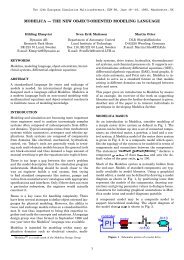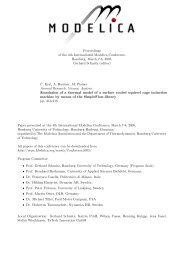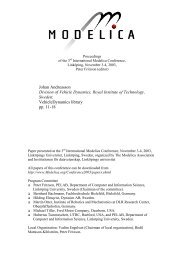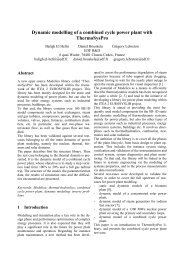Implementation of a Modelica Library
Implementation of a Modelica Library
Implementation of a Modelica Library
Create successful ePaper yourself
Turn your PDF publications into a flip-book with our unique Google optimized e-Paper software.
Figure 12 : PWH model under <strong>Modelica</strong>/Dymola<br />
5 <strong>Modelica</strong> and EMTP<br />
5.1 Validation <strong>of</strong> <strong>Modelica</strong> modeling<br />
Some simulations have been done in order to validate<br />
the model developed with the <strong>Modelica</strong> language.<br />
To do so, EMTP has been considered as the<br />
benchmark tool.<br />
Under Dymola and EMTP, all the electrical signals<br />
belonging respectively to the PWH and the MV network<br />
are identical. In this paper, only the fault current<br />
is presented (Figure 13).<br />
It is obtained from simulations performed on<br />
models given in Figure 4 and Figure 8. The fault current<br />
values are identical such as the fault clearance<br />
time due the PWH action.<br />
Figure 13 : Phase-to-ground fault current<br />
Blue : EMTP Red : <strong>Modelica</strong>/Dymola<br />
The fault occurs<br />
The fault is<br />
eliminated by the<br />
PWH <strong>of</strong> the faulty<br />
feeder<br />
5.2 <strong>Modelica</strong> and EMTP modeling comparison<br />
The <strong>Modelica</strong> model, with all components created<br />
by the user (Figure 8) is compared with the EMTP<br />
model (Figure 4). EMTP has, for the electrical power<br />
part, implicit components and, for the control command<br />
part, elementary explicit blocks. These components<br />
are not modifiable and thereby to develop<br />
new components, the user has to :<br />
Either create more or less difficult elementary<br />
components associations,<br />
Or build a DLL with S-function.<br />
For the use case considered in this paper, only<br />
explicit and implicit blocks were used. Thus, given<br />
the basic components available in EMTP, some<br />
tricks have been used to model the treatment <strong>of</strong> the<br />
multiplier outputs named DPN and DPP (Figure 14).<br />
From this very simple case, it is not difficult to understand<br />
that it would be very difficult to implement<br />
and verify more complex systems such as distance<br />
protections or advanced functions developed in the<br />
SmartGrid. Although this may not be unfeasible (to<br />
be validated according to the available basic blocks),<br />
these developments would be difficult without any<br />
guarantee <strong>of</strong> success. Moreover, the level <strong>of</strong> readability<br />
<strong>of</strong> such models would be bad and this approach<br />
leads to an increase <strong>of</strong> the number <strong>of</strong> variables and<br />
thus unnecessarily constraints the solver.<br />
In the opposite, <strong>Modelica</strong> models are simpler because<br />
the different blocks <strong>of</strong> the explicit PWH can be<br />
defined by the user. In other words, rather than associating<br />
basic blocks <strong>of</strong> the native library <strong>of</strong> <strong>Modelica</strong>,<br />
the user can create more adapted components or<br />
modify some existing blocks. Moreover, the <strong>Modelica</strong><br />
language provides all specific language paradigms<br />
for algorithm developments and so, unlike EMTP,<br />
statements related to the treatment <strong>of</strong> the multiplier<br />
are close to the description given in the PWH specification<br />
paper (Figure 14 and Figure 15).
















